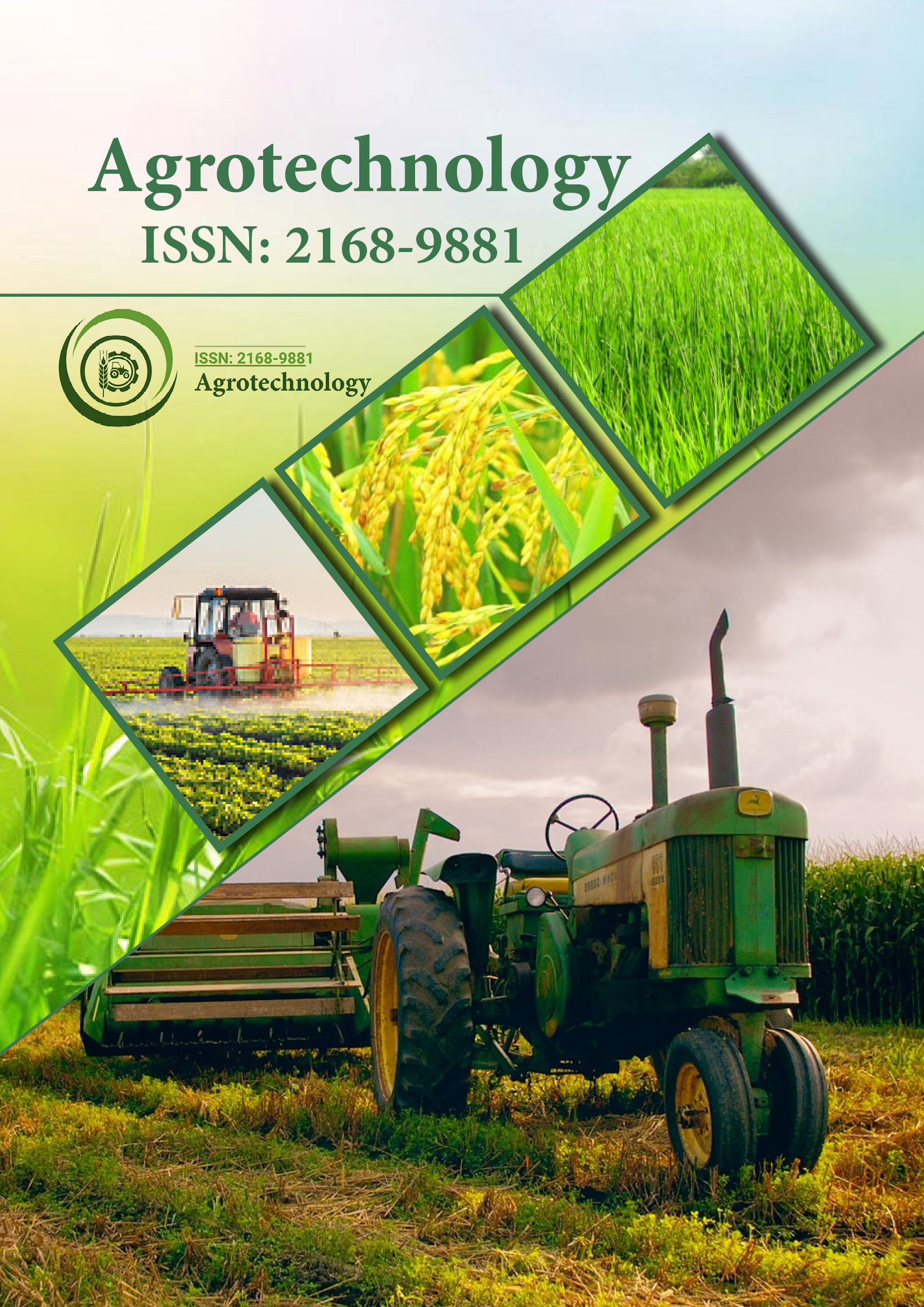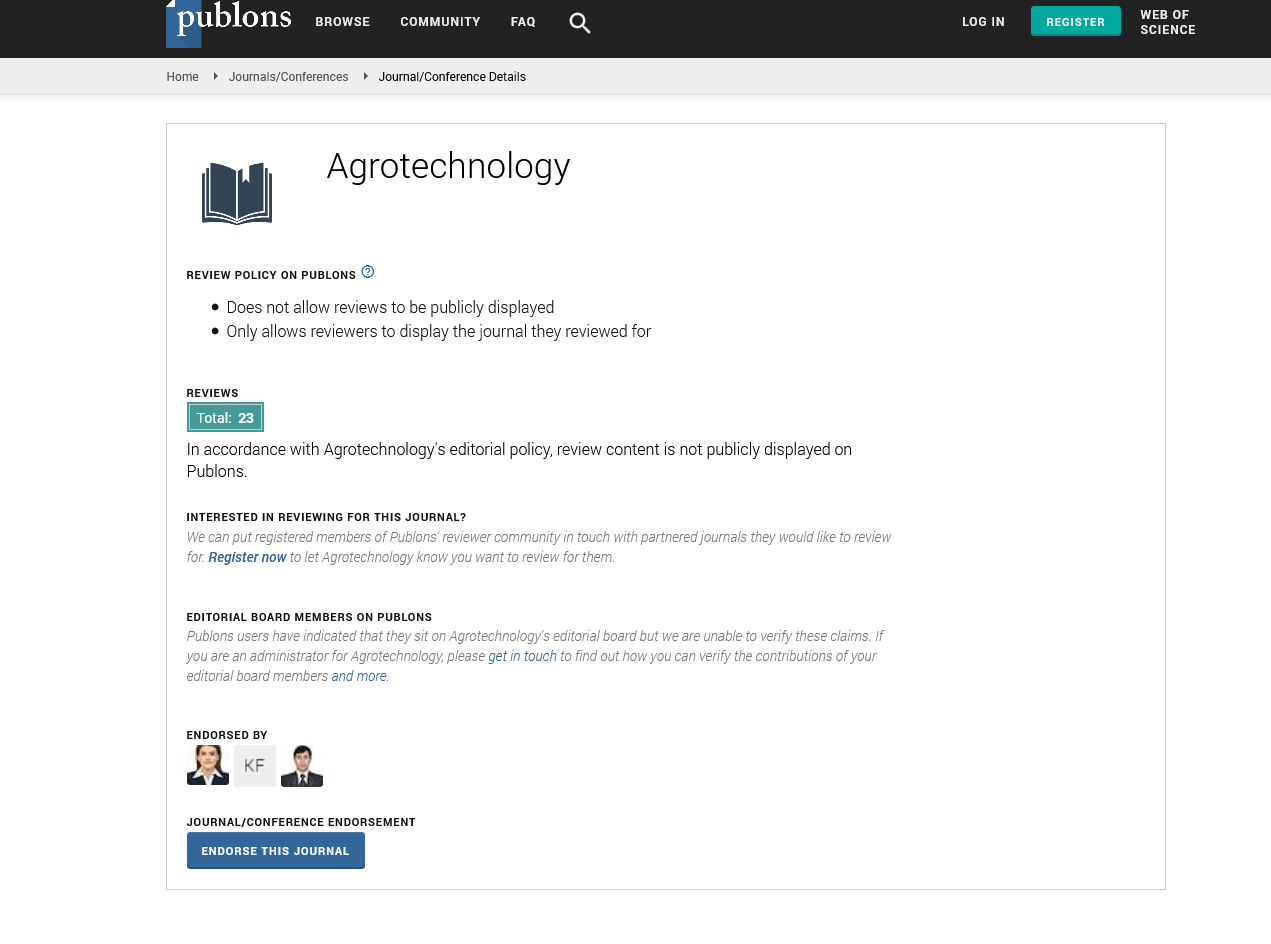Indexed In
- Open J Gate
- Genamics JournalSeek
- Academic Keys
- ResearchBible
- Cosmos IF
- Access to Global Online Research in Agriculture (AGORA)
- Electronic Journals Library
- RefSeek
- Directory of Research Journal Indexing (DRJI)
- Hamdard University
- EBSCO A-Z
- OCLC- WorldCat
- Scholarsteer
- SWB online catalog
- Virtual Library of Biology (vifabio)
- Publons
- Geneva Foundation for Medical Education and Research
- Euro Pub
- Google Scholar
Useful Links
Share This Page
Journal Flyer

Open Access Journals
- Agri and Aquaculture
- Biochemistry
- Bioinformatics & Systems Biology
- Business & Management
- Chemistry
- Clinical Sciences
- Engineering
- Food & Nutrition
- General Science
- Genetics & Molecular Biology
- Immunology & Microbiology
- Medical Sciences
- Neuroscience & Psychology
- Nursing & Health Care
- Pharmaceutical Sciences
Commentary - (2024) Volume 13, Issue 3
Efficient Degradation of Dichlorodiphenyltrichloroethane in Cotton Farms
Hui Luo*Received: 23-Aug-2024, Manuscript No. AGT-24-26684; Editor assigned: 26-Aug-2024, Pre QC No. AGT-24-26684 (PQ); Reviewed: 10-Sep-2024, QC No. AGT-24-26684; Revised: 17-Sep-2024, Manuscript No. AGT-24-26684 (R); Published: 25-Sep-2024, DOI: 10.35248/2168-9891.24.13.377
Description
The historical use of Dichlorodiphenyltrichloroethane (DDT) in cotton farming has left a lasting impact on agricultural landscapes, particularly in regions where it was extensively applied. While DDT was initially hailed for its effectiveness in controlling pests, its persistence in the environment and harmful effects on wildlife and human health led to its eventual ban in many countries. Understanding the degradation of DDT in soil is essential for assessing long-term environmental and health risks. Farming techniques play a significant role in this process, influencing the rate at which DDT breaks down and is removed from the ecosystem. This article describes the effect of various farming techniques on the degradation of DDT in historical cotton farms, emphasizing sustainable practices that can mitigate its legacy.
DDT is known for its persistence in the environment due to its chemical stability. Once applied, it can remain in the soil for decades, undergoing slow degradation through chemical, biological, and photolytic processes. The degradation of DDT results in the formation of several metabolites, including DDE (Di-chlorodiphenyldichloroethylene) and DDD (Di-chlorodiphenyl-dichloroethane), which are also persistent and toxic. Therefore, the goal is not only to degrade DDT but also to ensure the safe breakdown of its byproducts.
Soil properties significantly influence the degradation rate of DDT. Factors such as pH, organic matter content, moisture, and microbial activity all play a role. Farming techniques that alter these soil properties can therefore impact DDT degradation. Traditional tillage, crop rotation, organic amendments, and cover cropping are some of the practices that have been studied for their effects on DDT degradation.
Conventional tillage, which involves turning over the soil to prepare for planting, can enhance the degradation of DDT by increasing aeration and microbial activity. When soil is tilled, it exposes buried DDT residues to air and sunlight, which can accelerate their breakdown through photo degradation and microbial metabolism. However, excessive tillage can lead to soil erosion and loss of organic matter, which may counteract its benefits by reducing soil health and microbial diversity over time.
Crop rotation, the practice of growing different types of crops in succession on the same land, can also influence DDT degradation. Different crops contribute to varying root exudates and organic residues, which can affect soil microbial communities. For instance, leguminous crops, which fix atmospheric nitrogen, can enhance microbial activity and diversity in the soil, promoting the biodegradation of DDT. Additionally, crop rotation can help break pest and disease cycles, reducing the need for chemical pesticides and minimizing further contamination.
The addition of organic amendments, such as compost, manure, or biochar, has shown potential in enhancing the degradation of DDT. Organic matter provides a source of carbon and nutrients for soil microorganisms, boosting their activity and abundance. These amendments can also improve soil structure, water retention, and aeration, creating a more favorable environment for microbial degradation processes. Biochar, a form of charcoal produced from organic materials, has been particularly effective due to its high surface area and adsorption properties, which can immobilize DDT and its metabolites, reducing their bioavailability and promoting degradation.
Cover cropping, the practice of growing certain plants to cover the soil rather than for harvest, offers multiple benefits for soil health and DDT degradation. Cover crops protect the soil from erosion, improve soil structure, and enhance organic matter content. They also stimulate microbial activity through root exudates and organic residues. For example, cover crops like clover and ryegrass have been shown to promote the degradation of DDT by increasing microbial biomass and diversity. Moreover, the roots of cover crops can penetrate compacted soils, improving aeration and water infiltration, which are critical for microbial degradation processes.
Bioremediation, the use of living organisms to degrade contaminants, is another potential approach for addressing DDT residues in historical cotton farms. Certain bacteria and fungi have the ability to degrade DDT and its metabolites. Introducing or stimulating these microorganisms in the soil can enhance DDT degradation. For example, the bacteria Pseudomonas and the fungus Phanerochaete, Chrysosporium have shown potential in breaking down DDT in contaminated soils. These organisms can be introduced through bioaugmentation or stimulated through the addition of specific nutrients and organic matter.
Phytoremediation, the use of plants to remove or degrade contaminants, is also an emerging technique for addressing DDT contamination. Certain plants, known as hyper accumulators, can uptake and accumulate DDT in their tissues, effectively removing it from the soil. Other plants can enhance the microbial degradation of DDT in the rhizosphere, the zone of soil surrounding their roots. For example, plants like mustard and sunflower have been studied for their ability to accumulate and degrade DDT. Combining phytoremediation with other farming techniques, such as crop rotation and organic amendments, can create synergistic effects that enhance overall DDT degradation.
Despite the potential benefits of these farming techniques, several challenges remain. The effectiveness of DDT degradation can vary widely depending on local soil and climatic conditions. Long-term monitoring and site-specific management are essential to assess and optimize the effectiveness of different practices. Additionally, there is a need for further research to understand the mechanisms of DDT degradation and to develop innovative approaches for enhancing these processes.
In conclusion, the degradation of DDT in historical cotton farms is a complex process influenced by various farming techniques. Practices such as conventional tillage, crop rotation, organic amendments, cover cropping, bioremediation, and phytoremediation can enhance the breakdown of DDT and its metabolites, reducing their persistence and toxicity. Adopting sustainable farming techniques not only helps mitigate the legacy of DDT but also promotes overall soil health and agricultural sustainability. By understanding and optimizing these practices, farmers can contribute to a cleaner environment and safer food production systems. Through continued research and innovation, the agricultural community can develop effective strategies to address the challenges of historical pesticide contamination and pave the way for a more sustainable future.
Citation: Luo H (2024). Efficient Degradation of Dichlorodiphenyltrichloroethane in Cotton Farms. Agrotechnology. 13:377.
Copyright: © 2024 Luo H. This is an open access article distributed under the terms of the Creative Commons Attribution License, which permits unrestricted use, distribution, and reproduction in any medium, provided the original author and source are credited.


